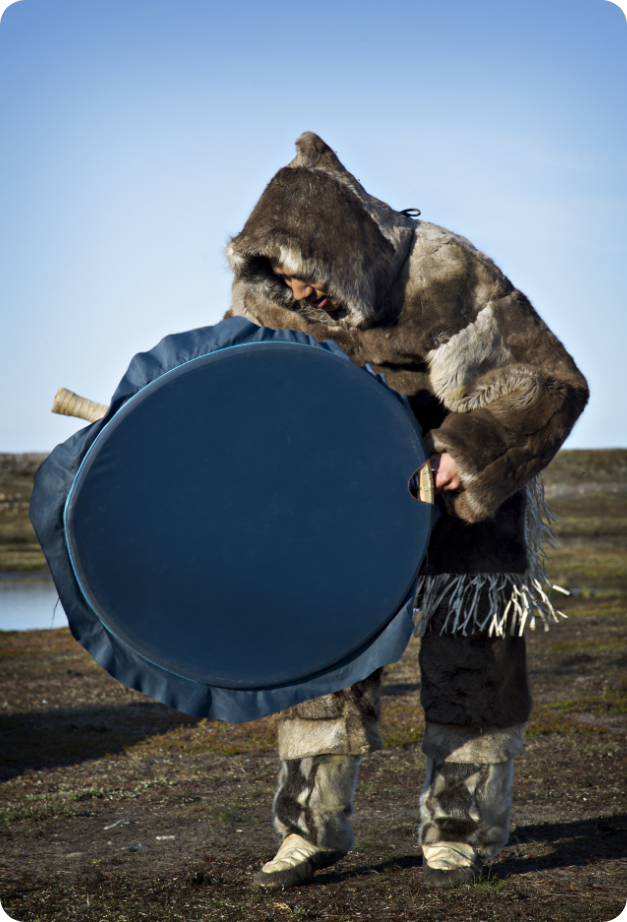Nunavummiut Greatly Appreciate Good Music, Dance And Drama!
At specific times of the year — such as when the sun returns to end the long, dark winter night, at the beginning of springtime and when summer finally arrives — communities all across Nunavut stage celebrations and games. These events include traditional Inuit performing arts, like storytelling, throat-singing and drum dancing, while also staging traditional Inuit games, which are athletic competitions of strength, agility, dexterity and stamina based on critical skills honed for excellence in hunting and arctic survival. These festive events often feature live music, dancing, theatrical performances and circus acts, plus they include communal feasts of traditional Inuit foods that are prepared for one and all to enjoy!
Traditional Inuit music is based around drums used in dance music and storytelling, plus a vocal style called ‘katajjaq’ in Inuktitut, Inuit throat-singing, which has become popular in Canada and abroad. The technical characteristics of Inuit music include story singing, complex rhythmic organization, relatively small melodic range averaging about a sixth, prominence of major thirds and minor seconds melodically, with undulating movement.
The Copper Inuit living near the Coppermine River in the western Kitikmeot region have two categories of music. A song is called ‘pisik’ if the performer also plays drums, and ‘aton’ if the performer only dances.
This is a popular summertime cultural event in Iqaluit, taking place in late June to early July, that features performing and visual artists from Nunavut and around the world for several days of music, theatre, film, circus acts and storytelling. This event is now combined with the Nunavut Arts and Crafts Association (NACA) annual summer showcase to see non-performing artists at work.
www.alianait.ca
www.nacaarts.org
An annual Igloolik festival of music, dance, acrobatic and theatrical performances that takes place in mid-to-late June. www.isuma.tv/hi/en/igloolik-bands/rockin-walrus-arts-festival-13. Traditional Inuit cultural activities and the performing arts are showcased every spring and summer in Iqaluit at two very popular festivals that feature many amazing musical artists.
Iqaluit’s spring festival is held every April. It is a weeklong event that includes traditional Inuit games and activities such as igloo building, dogsled races, snowmobile races, seal skinning contests, musical performances and feasts.
www.tooniktyme.com
When visitors witness Nunavut athletes performing traditional Inuit games for the first time, with huge jumps and dazzling acrobatic skill, they see how these powerful abilities have now been incorporated into the repertoires of dance groups like the Clyde River Hip Hoppers and in circus troupes like Artcirq from Igloolik.
The performance art of staged live theatre in Nunavut is culturally based in the ancient Inuit traditions of storytelling and shamanic ritual. The unique and often very contemporary worldview of the Inuit people is a truly fresh perspective in the dramatic narrative arts. The most famous theatre group in Nunavut is based in Pond Inlet.
Famous Igloolik arctic circus troupe that performed during the opening ceremonies of the 2010 Winter Olympic Games.
www.artcirq.org
For over 20 years now, Pond Inlet has been host to a thriving local community theatre group. Founded in 1987, the Tununiq Arsarniit Theatre Group develops its plays and performances by consensus, involving elders as both actors and writers, always weaving Inuit language and traditional culture into every dramatic issue it tackles for the stage.
Contact: Sheena Akoomalik
Email: akoomalik@hotmail.com
The Inuit Performance Art Of Throat-Singing, Called 'Katajjaq' In Inuktitut, Is The Only Vocal Game Of Its Kind In The World.
Until the arrival of Europeans and Americans, followed by the advent of musical recording technologies, Inuit music was traditionally only used in spiritual ceremonies, often to ask the spirits for good luck in hunting, as well as in simple lullabies for children. Unlike most cultures, traditional Inuit music is remarkable for its stoic lack of work songs and love songs. Inuit musical traditions were modified with the arrival of foreign sailors, especially those from Scotland. The Inuit soon learned to play these whalers’ musical instruments, the accordion and the fiddle, as they learned to dance jigs and reels.
Inuit throat-singing (‘katajjaq’) is a type of traditional competitive song, considered a game, usually held between two women. It is one of the world’s few examples of overtone singing, a very unique method of producing sounds vocally. When competing, two women stand face-to-face and sing using a complex method of following each other, so that one voice hits a strong accent while the other hits a weak one, melding their voices into a nearly indistinguishable single sound. They repeat brief motifs at staggered intervals, often imitating natural sounds, like those of geese, caribou or other wildlife, until one runs out of breath, trips over her tongue, or begins laughing — at which point the contest is concluded. This vocal game is totally unique to the Inuit!
The main Inuit percussion instrument is the wooden frame drum called the ‘qilaut’ that is made from bending narrow strips of wood into a circular frame with a handle protruding. Originally, caribou skin was stretched across the frame. Nowadays synthetic membranes are used. These drums can reach a metre (three feet) in diameter but are usually smaller. It is struck on the edge of the rim with a ‘qatuk,’ a wooden stick, wand or beater. The sound is a combination of the percussive whack on the wood and the resulting deep vibrations from the stretched membrane.
The Inuit art of throat-singing, like Inuit drum dancing, has been enjoyed since time immemorial yet as other musical traditions, instruments and sounds arrived in Nunavut, they have been combined and merged with the expressive musical forms of the native people. Many Inuit enjoy the accordion and fiddle sounds introduced to them by whalers and fur traders. Acoustic and electric guitars are now played everywhere in the territory, producing folk, country, pop and rock music in Nunavut with a distinctly northern artistic flair. Sounding as if it were perhaps invented specifically for another modern musical form adored by youth, the Inuktitut language is brilliantly suited for hip hop lyrics!
Arviat has strong musical roots and traditions. It is the home of renowned Inuit performers Charlie Panigoniak and Susan Aglukark. In the fall, Arviat hosts the Inuumariit Music Festival.


